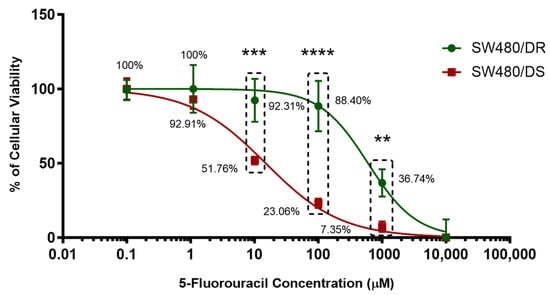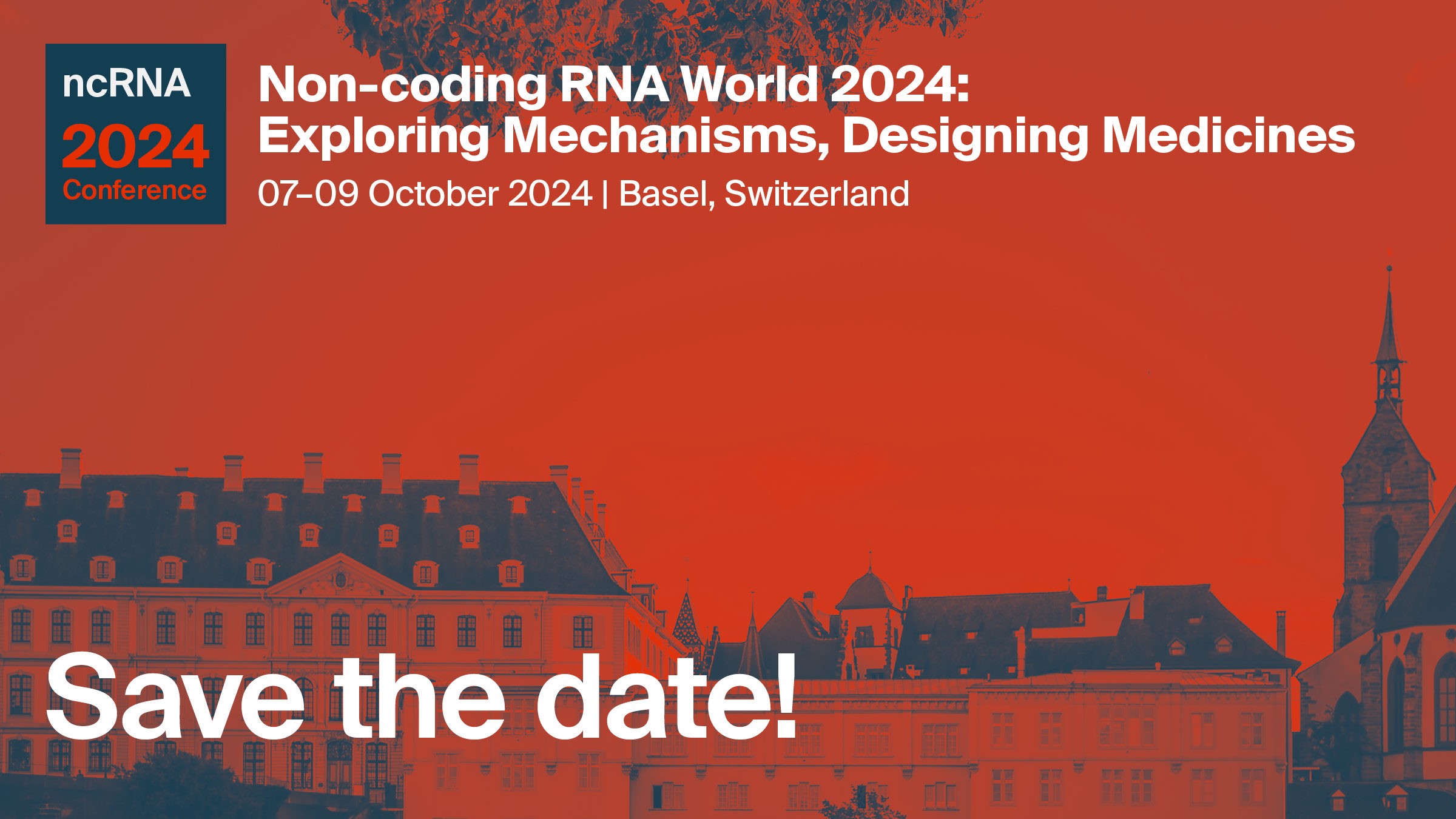Journal Description
Non-Coding RNA
Non-Coding RNA
is an international, peer-reviewed, open access journal on non-coding RNA research dealing with elucidating the structure, function and biology of regulatory non-coding RNAs. Non-Coding RNA is published bimonthly online by MDPI. Cardiolinc is affiliated with Non-Coding RNA.
- Open Access— free for readers, with article processing charges (APC) paid by authors or their institutions.
- High Visibility: indexed within Scopus, ESCI (Web of Science), PubMed, PMC, CAPlus / SciFinder, and other databases.
- Journal Rank: CiteScore - Q1 (Genetics)
- Rapid Publication: manuscripts are peer-reviewed and a first decision is provided to authors approximately 16.6 days after submission; acceptance to publication is undertaken in 3.6 days (median values for papers published in this journal in the second half of 2023).
- Recognition of Reviewers: reviewers who provide timely, thorough peer-review reports receive vouchers entitling them to a discount on the APC of their next publication in any MDPI journal, in appreciation of the work done.
Impact Factor:
4.3 (2022)
Latest Articles
Possible Involvement of Long Non-Coding RNAs GNAS-AS1 and MIR205HG in the Modulation of 5-Fluorouracil Chemosensitivity in Colon Cancer Cells through Increased Extracellular Release of Exosomes
Non-Coding RNA 2024, 10(2), 25; https://0-doi-org.brum.beds.ac.uk/10.3390/ncrna10020025 - 15 Apr 2024
Abstract
A growing number of studies have suggested the involvement of long non-coding RNAs as the key players in not just the initiation and progression of the tumor microenvironment, but also in chemotherapy tolerance. In the present study, generated 5-FU-resistant SW480/DR cells were analyzed
[...] Read more.
A growing number of studies have suggested the involvement of long non-coding RNAs as the key players in not just the initiation and progression of the tumor microenvironment, but also in chemotherapy tolerance. In the present study, generated 5-FU-resistant SW480/DR cells were analyzed via cDNA microarray for its aberrant lncRNAs and mRNAs expression in comparison with the 5-FU-susceptible SW480/DS cells. Among the 126 lncRNAs described, lncRNAs GNAS-AS1, MIR205HG, and LOC102723721 have been identified to be significantly upregulated, while lncRNs lnc-RP11-597K23.2.1-2, LOC100507639, and CCDC144NL-AS1 have been found to be significantly downregulated. In the meantime, bioinformatic analysis through gene ontology studies of aberrantly expressed mRNAs revealed “regulated exocytosis”, among others, as the biological process most impacted in SW480/DR cells. To investigate, exosome purification was then carried out and its characterization were validated via transmission electron microscopy and nanoparticle tracking analysis. Interestingly, it was determined that the 5-FU-resistant SW480/DR cells secretes significantly higher concentration of extracellular vesicles, particularly, exosomes when compared to the 5-FU-susceptible SW480/DS cells. Based on the lncRNA-mRNA interaction network analysis generated, lncRNA GNAS-AS1 and MIR205HG have been identified to be potentially involved in the incidence of 5-FU resistance in SW480 colon cancer cells through promoting increased release of exosomes into the intercellular matrix. Our study hopes not only to provide insights on the list of involved candidate lncRNAs, but also to elucidate the role exosomes play in the initiation and development of 5-FU chemotherapy resistance in colon cancer cells.
Full article
(This article belongs to the Special Issue Molecular Mechanisms and Clinical Implications of Non-coding RNAs in Cancer)
►
Show Figures
Open AccessReview
miRNAs as Interconnectors between Obesity and Cancer
by
Grecia Denisse González-Sánchez, Angelica Judith Granados-López, Yamilé López-Hernández, Mayra Judith García Robles and Jesús Adrián López
Non-Coding RNA 2024, 10(2), 24; https://0-doi-org.brum.beds.ac.uk/10.3390/ncrna10020024 - 15 Apr 2024
Abstract
►▼
Show Figures
Obesity and cancer are a concern of global interest. It is proven that obesity may trigger the development or progression of some types of cancer; however, the connection by non-coding RNAs has not been totally explored. In the present review, we discuss miRNAs
[...] Read more.
Obesity and cancer are a concern of global interest. It is proven that obesity may trigger the development or progression of some types of cancer; however, the connection by non-coding RNAs has not been totally explored. In the present review, we discuss miRNAs and lncRNAs dysregulation involved in obesity and some cancers, shedding light on how these conditions may exacerbate one another through the dysregulation of ncRNAs. lncRNAs have been reported as regulating microRNAs. An in silico investigation of lncRNA and miRNA interplay is presented. Our investigation revealed 44 upregulated and 49 downregulated lncRNAs in obesity and cancer, respectively. miR-375, miR-494-3p, miR-1908, and miR-196 were found interacting with 1, 4, 4 and 4 lncRNAs, respectively, which are involved in PPARγ cell signaling regulation. Additionally, miR-130 was found to be downregulated in obesity and reported as modulating 5 lncRNAs controlling PPARγ cell signaling. Similarly, miR-128-3p and miR-143 were found to be downregulated in obesity and cancer, interacting with 5 and 4 lncRNAs, respectively, associated with MAPK cell signaling modulation. The delicate balance between miRNA and lncRNA expression emerges as a critical determinant in the development of obesity-associated cancers, presenting these molecules as promising biomarkers. However, additional and deeper studies are needed to reach solid conclusions about obesity and cancer connection by ncRNAs.
Full article

Figure 1
Open AccessArticle
Dynamic Localization of Paraspeckle Components under Osmotic Stress
by
Aysegul Yucel-Polat, Danae Campos-Melo, Asieh Alikhah and Michael J. Strong
Non-Coding RNA 2024, 10(2), 23; https://0-doi-org.brum.beds.ac.uk/10.3390/ncrna10020023 - 12 Apr 2024
Abstract
Paraspeckles are nuclear condensates formed by NEAT1_2 lncRNA and different RNA-binding proteins. In general, these membraneless organelles function in the regulation of gene expression and translation and in miRNA processing, and in doing this, they regulate cellular homeostasis and mediate pro-survival in the
[...] Read more.
Paraspeckles are nuclear condensates formed by NEAT1_2 lncRNA and different RNA-binding proteins. In general, these membraneless organelles function in the regulation of gene expression and translation and in miRNA processing, and in doing this, they regulate cellular homeostasis and mediate pro-survival in the cell. Despite evidence showing the importance of paraspeckles in the stress response, the dynamics of paraspeckles and their components under conditions of osmotic stress remain unknown. We exposed HEK293T cells to sorbitol and examined NEAT1_2 expression using real-time PCR. Localization and quantification of the main paraspeckle components, NEAT1_2, PSPC1, NONO, and SFPQ, in different cellular compartments was performed using smFISH and immunofluorescence. Our findings showed a significant decrease in total NEAT1_2 expression in cells after osmotic stress. Sorbitol shifted the subcellular localization of NEAT1_2, PSPC1, NONO, and SFPQ from the nucleus to the cytoplasm and decreased the number and size of NEAT1_2 foci in the nucleus. PSPC1 formed immunoreactive cytoplasmic fibrils under conditions of osmotic stress, which slowly disassembled under recovery. Our study deepens the paraspeckle dynamics in response to stress, suggesting a novel role for NEAT1_2 in the cytoplasm in osmotic stress and physiological conditions.
Full article
(This article belongs to the Section Long Non-Coding RNA)
►▼
Show Figures

Figure 1
Open AccessArticle
Functional Significance of miR-4693-5p in Targeting HIF1α and Its Link to Rheumatoid Arthritis Pathogenesis
by
Mohd Saquib, Prachi Agnihotri, Ashish Sarkar, Swati Malik, Sonia Mann, Debolina Chakraborty, Lovely Joshi, Rajesh Malhotra and Sagarika Biswas
Non-Coding RNA 2024, 10(2), 22; https://0-doi-org.brum.beds.ac.uk/10.3390/ncrna10020022 - 10 Apr 2024
Abstract
Rheumatoid arthritis (RA) is a chronic inflammatory autoimmune disease that causes joint inflammation and destruction with an unknown origin. Our study aims to elucidate the molecular mechanism behind HIF1α overexpression in RA. Dysregulated miRNA expressions are known to influence gene behavior, thereby enhancing
[...] Read more.
Rheumatoid arthritis (RA) is a chronic inflammatory autoimmune disease that causes joint inflammation and destruction with an unknown origin. Our study aims to elucidate the molecular mechanism behind HIF1α overexpression in RA. Dysregulated miRNA expressions are known to influence gene behavior, thereby enhancing cell proliferation, inflammation, and resistance to apoptosis, contributing to RA development. Our earlier finding indicated that exogenous miRNA similar to miR-4693-5p may modulate RA-related targets. However, the specific role of miR-4693-5p and its targets in RA remain unexplored. In this study, we found that miR-4693-5p was significantly reduced in PBMCs of RA patients, with evidence suggesting it targets the 3′ UTR of HIF1α, thereby potentially contributing to its overexpression in RA. In vitro overexpression of miR-4693-5p leads to the knockdown of HIF1α, resulting in inhibited expression of Survivin to disrupt apoptosis resistance, inflammation suppression, and a reduction in the total cellular ROS response in SW982 and RAFLS cells. The results were validated using the CIA Rat model. In conclusion, this study provides a crucial foundation for understanding the functional role of miR-4693-5p. These findings improve our understanding and provide novel insights into the molecular mechanisms underlying RA pathogenesis.
Full article
(This article belongs to the Topic MicroRNA: Mechanisms of Action, Physio-Pathological Implications, and Disease Biomarkers, 2nd Volume)
►▼
Show Figures

Figure 1
Open AccessReview
More than the SRY: The Non-Coding Landscape of the Y Chromosome and Its Importance in Human Disease
by
Emily S. Westemeier-Rice, Michael T. Winters, Travis W. Rawson and Ivan Martinez
Non-Coding RNA 2024, 10(2), 21; https://0-doi-org.brum.beds.ac.uk/10.3390/ncrna10020021 - 10 Apr 2024
Abstract
Historically, the Y chromosome has presented challenges to classical methodology and philosophy of understanding the differences between males and females. A genetic unsolved puzzle, the Y chromosome was the last chromosome to be fully sequenced. With the advent of the Human Genome Project
[...] Read more.
Historically, the Y chromosome has presented challenges to classical methodology and philosophy of understanding the differences between males and females. A genetic unsolved puzzle, the Y chromosome was the last chromosome to be fully sequenced. With the advent of the Human Genome Project came a realization that the human genome is more than just genes encoding proteins, and an entire universe of RNA was discovered. This dark matter of biology and the black box surrounding the Y chromosome have collided over the last few years, as increasing numbers of non-coding RNAs have been identified across the length of the Y chromosome, many of which have played significant roles in disease. In this review, we will uncover what is known about the connections between the Y chromosome and the non-coding RNA universe that originates from it, particularly as it relates to long non-coding RNAs, microRNAs and circular RNAs.
Full article
(This article belongs to the Special Issue Selected Papers from IEEE BIBM 2021 Workshop on Long Non-coding RNAs: Mechanism, Function, and Computational Analysis (BIBM-LncRNA))
►▼
Show Figures
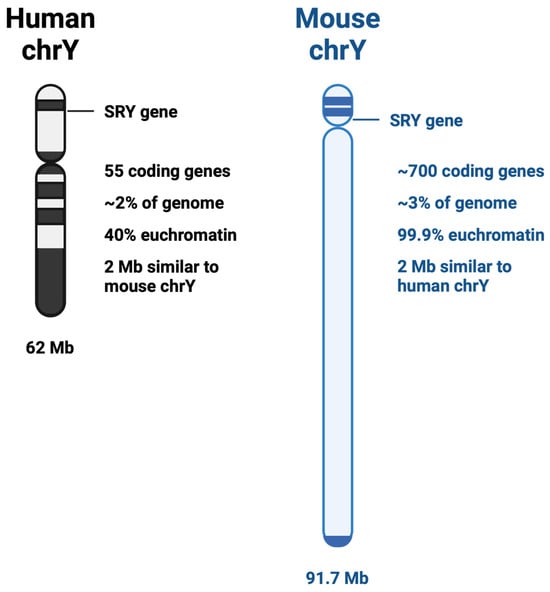
Figure 1
Open AccessFeature PaperArticle
FuncPEP v2.0: An Updated Database of Functional Short Peptides Translated from Non-Coding RNAs
by
Swati Mohapatra, Anik Banerjee, Paola Rausseo, Mihnea P. Dragomir, Ganiraju C. Manyam, Bradley M. Broom and George A. Calin
Non-Coding RNA 2024, 10(2), 20; https://0-doi-org.brum.beds.ac.uk/10.3390/ncrna10020020 - 09 Apr 2024
Abstract
►▼
Show Figures
Over the past decade, there have been reports of short novel functional peptides (less than 100 aa in length) translated from so-called non-coding RNAs (ncRNAs) that have been characterized using mass spectrometry (MS) and large-scale proteomics studies. Therefore, understanding the bivalent functions of
[...] Read more.
Over the past decade, there have been reports of short novel functional peptides (less than 100 aa in length) translated from so-called non-coding RNAs (ncRNAs) that have been characterized using mass spectrometry (MS) and large-scale proteomics studies. Therefore, understanding the bivalent functions of some ncRNAs as transcripts that encode both functional RNAs and short peptides, which we named ncPEPs, will deepen our understanding of biology and disease. In 2020, we published the first database of functional peptides translated from non-coding RNAs—FuncPEP. Herein, we have performed an update including the newly published ncPEPs from the last 3 years along with the categorization of host ncRNAs. FuncPEP v2.0 contains 152 functional ncPEPs, out of which 40 are novel entries. A PubMed search from August 2020 to July 2023 incorporating specific keywords was performed and screened for publications reporting validated functional peptides derived from ncRNAs. We did not observe a significant increase in newly discovered functional ncPEPs, but a steady increase. The novel identified ncPEPs included in the database were characterized by a wide array of molecular and physiological parameters (i.e., types of host ncRNA, species distribution, chromosomal density, distribution of ncRNA length, identification methods, molecular weight, and functional distribution across humans and other species). We consider that, despite the fact that MS can now easily identify ncPEPs, there still are important limitations in proving their functionality.
Full article

Figure 1
Open AccessReview
Functions of RNAi Pathways in Ribosomal RNA Regulation
by
Aleksei S. Shatskikh, Elena A. Fefelova and Mikhail S. Klenov
Non-Coding RNA 2024, 10(2), 19; https://0-doi-org.brum.beds.ac.uk/10.3390/ncrna10020019 - 29 Mar 2024
Abstract
Argonaute proteins, guided by small RNAs, play crucial roles in gene regulation and genome protection through RNA interference (RNAi)-related mechanisms. Ribosomal RNAs (rRNAs), encoded by repeated rDNA units, constitute the core of the ribosome being the most abundant cellular transcripts. rDNA clusters also
[...] Read more.
Argonaute proteins, guided by small RNAs, play crucial roles in gene regulation and genome protection through RNA interference (RNAi)-related mechanisms. Ribosomal RNAs (rRNAs), encoded by repeated rDNA units, constitute the core of the ribosome being the most abundant cellular transcripts. rDNA clusters also serve as sources of small RNAs, which are loaded into Argonaute proteins and are able to regulate rDNA itself or affect other gene targets. In this review, we consider the impact of small RNA pathways, specifically siRNAs and piRNAs, on rRNA gene regulation. Data from diverse eukaryotic organisms suggest the potential involvement of small RNAs in various molecular processes related to the rDNA transcription and rRNA fate. Endogenous siRNAs are integral to the chromatin-based silencing of rDNA loci in plants and have been shown to repress rDNA transcription in animals. Small RNAs also play a role in maintaining the integrity of rDNA clusters and may function in the cellular response to rDNA damage. Studies on the impact of RNAi and small RNAs on rRNA provide vast opportunities for future exploration.
Full article
(This article belongs to the Special Issue Small RNAs – Big Roles: IsomiRs, tRNA Fragments, and rRNA Fragments in Human Health and Disease)
►▼
Show Figures

Figure 1
Open AccessReview
Circulating miRNAs as Novel Clinical Biomarkers in Temporal Lobe Epilepsy
by
Lorenza Guarnieri, Nicola Amodio, Francesca Bosco, Sara Carpi, Martina Tallarico, Luca Gallelli, Vincenzo Rania, Rita Citraro, Antonio Leo and Giovambattista De Sarro
Non-Coding RNA 2024, 10(2), 18; https://0-doi-org.brum.beds.ac.uk/10.3390/ncrna10020018 - 17 Mar 2024
Abstract
Temporal lobe epilepsy (TLE) represents the most common form of refractory focal epilepsy. The identification of innovative clinical biomarkers capable of categorizing patients with TLE, allowing for improved treatment and outcomes, still represents an unmet need. Circulating microRNAs (c-miRNAs) are short non-coding RNAs
[...] Read more.
Temporal lobe epilepsy (TLE) represents the most common form of refractory focal epilepsy. The identification of innovative clinical biomarkers capable of categorizing patients with TLE, allowing for improved treatment and outcomes, still represents an unmet need. Circulating microRNAs (c-miRNAs) are short non-coding RNAs detectable in body fluids, which play crucial roles in the regulation of gene expression. Their characteristics, including extracellular stability, detectability through non-invasive methods, and responsiveness to pathological changes and/or therapeutic interventions, make them promising candidate biomarkers in various disease settings. Recent research has investigated c-miRNAs in various bodily fluids, including serum, plasma, and cerebrospinal fluid, of TLE patients. Despite some discrepancies in methodologies, cohort composition, and normalization strategies, a common dysregulated signature of c-miRNAs has emerged across different studies, providing the basis for using c-miRNAs as novel biomarkers for TLE patient management.
Full article
(This article belongs to the Collection Feature Papers in Non-Coding RNA)
Open AccessReview
Targeting MicroRNAs with Small Molecules
by
Kisanet Tadesse and Raphael I. Benhamou
Non-Coding RNA 2024, 10(2), 17; https://0-doi-org.brum.beds.ac.uk/10.3390/ncrna10020017 - 14 Mar 2024
Abstract
MicroRNAs (miRs) have been implicated in numerous diseases, presenting an attractive target for the development of novel therapeutics. The various regulatory roles of miRs in cellular processes underscore the need for precise strategies. Recent advances in RNA research offer hope by enabling the
[...] Read more.
MicroRNAs (miRs) have been implicated in numerous diseases, presenting an attractive target for the development of novel therapeutics. The various regulatory roles of miRs in cellular processes underscore the need for precise strategies. Recent advances in RNA research offer hope by enabling the identification of small molecules capable of selectively targeting specific disease-associated miRs. This understanding paves the way for developing small molecules that can modulate the activity of disease-associated miRs. Herein, we discuss the progress made in the field of drug discovery processes, transforming the landscape of miR-targeted therapeutics by small molecules. By leveraging various approaches, researchers can systematically identify compounds to modulate miR function, providing a more potent intervention either by inhibiting or degrading miRs. The implementation of these multidisciplinary approaches bears the potential to revolutionize treatments for diverse diseases, signifying a significant stride towards the targeting of miRs by precision medicine.
Full article
(This article belongs to the Special Issue Recent Advances in Chemical Biology to Study and Target ncRNAs)
►▼
Show Figures

Figure 1
Open AccessReview
miR-125 in Breast Cancer Etiopathogenesis: An Emerging Role as a Biomarker in Differential Diagnosis, Regenerative Medicine, and the Challenges of Personalized Medicine
by
Roberto Piergentili, Enrico Marinelli, Gaspare Cucinella, Alessandra Lopez, Gabriele Napoletano, Giuseppe Gullo and Simona Zaami
Non-Coding RNA 2024, 10(2), 16; https://0-doi-org.brum.beds.ac.uk/10.3390/ncrna10020016 - 21 Feb 2024
Abstract
Breast Cancer (BC) is one of the most common cancer types worldwide, and it is characterized by a complex etiopathogenesis, resulting in an equally complex classification of subtypes. MicroRNA (miRNA or miR) are small non-coding RNA molecules that have an essential role in
[...] Read more.
Breast Cancer (BC) is one of the most common cancer types worldwide, and it is characterized by a complex etiopathogenesis, resulting in an equally complex classification of subtypes. MicroRNA (miRNA or miR) are small non-coding RNA molecules that have an essential role in gene expression and are significantly linked to tumor development and angiogenesis in different types of cancer. Recently, complex interactions among coding and non-coding RNA have been elucidated, further shedding light on the complexity of the roles these molecules fulfill in cancer formation. In this context, knowledge about the role of miR in BC has significantly improved, highlighting the deregulation of these molecules as additional factors influencing BC occurrence, development and classification. A considerable number of papers has been published over the past few years regarding the role of miR-125 in human pathology in general and in several types of cancer formation in particular. Interestingly, miR-125 family members have been recently linked to BC formation as well, and complex interactions (competing endogenous RNA networks, or ceRNET) between this molecule and target mRNA have been described. In this review, we summarize the state-of-the-art about research on this topic.
Full article
(This article belongs to the Special Issue Current Strategies to Investigate the Role of ncRNAs in Carcinogenesis)
►▼
Show Figures

Figure 1
Open AccessArticle
Topographic Distribution of miRNAs (miR-30a, miR-223, miR-let-7a, miR-let-7f, miR-451, and miR-486) in the Plasma Extracellular Vesicles
by
Tatiana Petrova, Olga Kalinina, Arthur Aquino, Evgeniy Grigoryev, Natallia V. Dubashynskaya, Kseniya Zubkova, Anna Kostareva and Alexey Golovkin
Non-Coding RNA 2024, 10(1), 15; https://0-doi-org.brum.beds.ac.uk/10.3390/ncrna10010015 - 15 Feb 2024
Abstract
There are many articles on the quantitative analysis of miRNAs contained in a population of EVs of different sizes under various physiological and pathological conditions. For such analysis, it is important to correctly quantify the miRNA contents of EVs. It should be considered
[...] Read more.
There are many articles on the quantitative analysis of miRNAs contained in a population of EVs of different sizes under various physiological and pathological conditions. For such analysis, it is important to correctly quantify the miRNA contents of EVs. It should be considered that quantification is skewed depending on the isolation protocol, and different miRNAs are degraded by nucleases with different efficiencies. In addition, it is important to consider the contribution of miRNAs coprecipitating with the EVs population, because the amount of miRNAs in the EVs population under study is skewed without appropriate enzymatic treatment. By studying a population of EVs from the blood plasma of healthy donors, we found that the absolute amount of miRNA inside the vesicles is commensurate with the amount of the same type of miRNA adhered to the outside of the EVs. The inside/outside ratio ranged from 1.02 to 2.64 for different investigated miRNAs. According to our results, we propose the hypothesis that high occupancy of miRNAs on the outer surface of EVs influence on the transporting RNA repertoire no less than the inner cargo received from the host cell.
Full article
(This article belongs to the Special Issue Extracellular Vesicles and ncRNA)
►▼
Show Figures
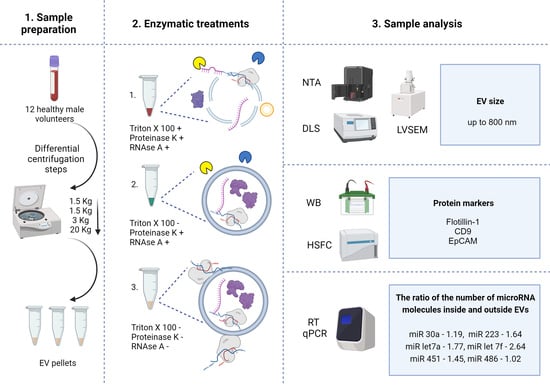
Graphical abstract
Open AccessArticle
MicroRNA-204 Regulates Angiogenesis and Vasculogenic Mimicry in CD44+/CD24− Breast Cancer Stem-like Cells
by
Martha Resendiz-Hernández, Alejandra P. García-Hernández, Macrina B. Silva-Cázares, Rogelio Coronado-Uribe, Olga N. Hernández-de la Cruz, Lourdes A. Arriaga-Pizano, Jessica L. Prieto-Chávez, Yarely M. Salinas-Vera, Eloisa Ibarra-Sierra, Concepción Ortiz-Martínez and César López-Camarillo
Non-Coding RNA 2024, 10(1), 14; https://0-doi-org.brum.beds.ac.uk/10.3390/ncrna10010014 - 09 Feb 2024
Abstract
►▼
Show Figures
Tumors have high requirements in terms of nutrients and oxygen. Angiogenesis is the classical mechanism for vessel formation. Tumoral vascularization has the function of nourishing the cancer cells to support tumor growth. Vasculogenic mimicry, a novel intratumoral microcirculation system, alludes to the ability
[...] Read more.
Tumors have high requirements in terms of nutrients and oxygen. Angiogenesis is the classical mechanism for vessel formation. Tumoral vascularization has the function of nourishing the cancer cells to support tumor growth. Vasculogenic mimicry, a novel intratumoral microcirculation system, alludes to the ability of cancer cells to organize in three-dimensional (3D) channel-like architectures. It also supplies the tumors with nutrients and oxygen. Both mechanisms operate in a coordinated way; however, their functions in breast cancer stem-like cells and their regulation by microRNAs remain elusive. In the present study, we investigated the functional role of microRNA-204 (miR-204) on angiogenesis and vasculogenic mimicry in breast cancer stem-like cells. Using flow cytometry assays, we found that 86.1% of MDA-MB-231 and 92% of Hs-578t breast cancer cells showed the CD44+/CD24− immunophenotype representative of cancer stem-like cells (CSCs). The MDA-MB-231 subpopulation of CSCs exhibited the ability to form mammospheres, as expected. Interestingly, we found that the restoration of miR-204 expression in CSCs significantly inhibited the number and size of the mammospheres. Moreover, we found that MDA-MB-231 and Hs-578t CSCs efficiently undergo angiogenesis and hypoxia-induced vasculogenic mimicry in vitro. The transfection of precursor miR-204 in both CSCs was able to impair the angiogenesis in the HUVEC cell model, which was observed as a diminution in the number of polygons and sprouting cells. Remarkably, miR-204 mimics also resulted in the inhibition of vasculogenic mimicry formation in MDA-MB-231 and Hs-578t CSCs, with a significant reduction in the number of channel-like structures and branch points. Mechanistically, the effects of miR-204 were associated with a diminution of pro-angiogenic VEGFA and β-catenin protein levels. In conclusion, our findings indicated that miR-204 abrogates the angiogenesis and vasculogenic mimicry development in breast cancer stem-like cells, suggesting that it could be a potential tool for breast cancer intervention based on microRNA replacement therapies.
Full article

Figure 1
Open AccessFeature PaperReview
The Emerging Role of Non-Coding RNAs (ncRNAs) in Plant Growth, Development, and Stress Response Signaling
by
Amit Yadav, Jyotirmaya Mathan, Arvind Kumar Dubey and Anuradha Singh
Non-Coding RNA 2024, 10(1), 13; https://0-doi-org.brum.beds.ac.uk/10.3390/ncrna10010013 - 07 Feb 2024
Abstract
Plant species utilize a variety of regulatory mechanisms to ensure sustainable productivity. Within this intricate framework, numerous non-coding RNAs (ncRNAs) play a crucial regulatory role in plant biology, surpassing the essential functions of RNA molecules as messengers, ribosomal, and transfer RNAs. ncRNAs represent
[...] Read more.
Plant species utilize a variety of regulatory mechanisms to ensure sustainable productivity. Within this intricate framework, numerous non-coding RNAs (ncRNAs) play a crucial regulatory role in plant biology, surpassing the essential functions of RNA molecules as messengers, ribosomal, and transfer RNAs. ncRNAs represent an emerging class of regulators, operating directly in the form of small interfering RNAs (siRNAs), microRNAs (miRNAs), long noncoding RNAs (lncRNAs), and circular RNAs (circRNAs). These ncRNAs exert control at various levels, including transcription, post-transcription, translation, and epigenetic. Furthermore, they interact with each other, contributing to a variety of biological processes and mechanisms associated with stress resilience. This review primarily concentrates on the recent advancements in plant ncRNAs, delineating their functions in growth and development across various organs such as root, leaf, seed/endosperm, and seed nutrient development. Additionally, this review broadens its scope by examining the role of ncRNAs in response to environmental stresses such as drought, salt, flood, heat, and cold in plants. This compilation offers updated information and insights to guide the characterization of the potential functions of ncRNAs in plant growth, development, and stress resilience in future research.
Full article
(This article belongs to the Special Issue Non-Coding RNA and Their Regulatory Roles in Plant)
►▼
Show Figures
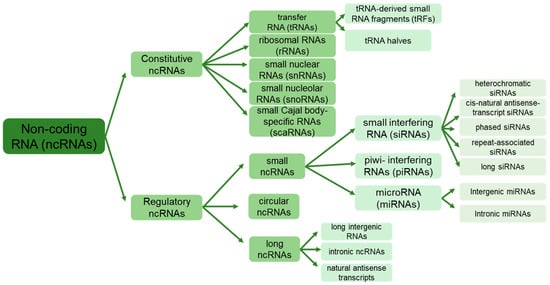
Figure 1
Open AccessReview
Functional Relevance of Extracellular Vesicle-Derived Long Non-Coding and Circular RNAs in Cancer Angiogenesis
by
José A. Peña-Flores, Daniela Muela-Campos, Rebeca Guzmán-Medrano, Diego Enríquez-Espinoza and Karla González-Alvarado
Non-Coding RNA 2024, 10(1), 12; https://0-doi-org.brum.beds.ac.uk/10.3390/ncrna10010012 - 06 Feb 2024
Abstract
Extracellular vesicles (EVs) are defined as subcellular structures limited by a bilayer lipid membrane that function as important intercellular communication by transporting active biomolecules, such as proteins, amino acids, metabolites, and nucleic acids, including long non-coding RNAs (lncRNAs). These cargos can effectively be
[...] Read more.
Extracellular vesicles (EVs) are defined as subcellular structures limited by a bilayer lipid membrane that function as important intercellular communication by transporting active biomolecules, such as proteins, amino acids, metabolites, and nucleic acids, including long non-coding RNAs (lncRNAs). These cargos can effectively be delivered to target cells and induce a highly variable response. LncRNAs are functional RNAs composed of at least 200 nucleotides that do not code for proteins. Nowadays, lncRNAs and circRNAs are known to play crucial roles in many biological processes, including a plethora of diseases including cancer. Growing evidence shows an active presence of lnc- and circRNAs in EVs, generating downstream responses that ultimately affect cancer progression by many mechanisms, including angiogenesis. Moreover, many studies have revealed that some tumor cells promote angiogenesis by secreting EVs, which endothelial cells can take up to induce new vessel formation. In this review, we aim to summarize the bioactive roles of EVs with lnc- and circRNAs as cargo and their effect on cancer angiogenesis. Also, we discuss future clinical strategies for cancer treatment based on current knowledge of circ- and lncRNA-EVs.
Full article
(This article belongs to the Special Issue Extracellular Vesicles and ncRNA)
►▼
Show Figures

Figure 1
Open AccessReview
Circular RNAs, Noncoding RNAs, and N6-methyladenosine Involved in the Development of MAFLD
by
Moeka Nakashima, Naoko Suga, Yuka Ikeda, Sayuri Yoshikawa and Satoru Matsuda
Non-Coding RNA 2024, 10(1), 11; https://0-doi-org.brum.beds.ac.uk/10.3390/ncrna10010011 - 05 Feb 2024
Cited by 1
Abstract
Noncoding RNAs (ncRNAs), including circular RNAs (circRNAs) and N6-methyladenosine (m6A), have been shown to play a critical role in the development of various diseases including obesity and metabolic disorder-associated fatty liver disease (MAFLD). Obesity is a chronic disease caused by excessive fat accumulation
[...] Read more.
Noncoding RNAs (ncRNAs), including circular RNAs (circRNAs) and N6-methyladenosine (m6A), have been shown to play a critical role in the development of various diseases including obesity and metabolic disorder-associated fatty liver disease (MAFLD). Obesity is a chronic disease caused by excessive fat accumulation in the body, which has recently become more prevalent and is the foremost risk factor for MAFLD. Causes of obesity may involve the interaction of genetic, behavioral, and social factors. m6A RNA methylation might add a novel inspiration for understanding the development of obesity and MAFLD with post-transcriptional regulation of gene expression. In particular, circRNAs, microRNAs (miRNAs), and m6A might be implicated in the progression of MAFLD. Interestingly, m6A modification can modulate the translation, degradation, and other functions of ncRNAs. miRNAs/circRNAs can also modulate m6A modifications by affecting writers, erasers, and readers. In turn, ncRNAs could modulate the expression of m6A regulators in different ways. However, there is limited evidence on how these ncRNAs and m6A interact to affect the promotion of liver diseases. It seems that m6A can occur in DNA, RNA, and proteins that may be associated with several biological properties. This study provides a mechanistic understanding of the association of m6A modification and ncRNAs with liver diseases, especially for MAFLD. Comprehension of the association between m6A modification and ncRNAs may contribute to the development of treatment tactics for MAFLD.
Full article
(This article belongs to the Special Issue Non-coding RNAs: Multiple Players in Human Diseases)
►▼
Show Figures
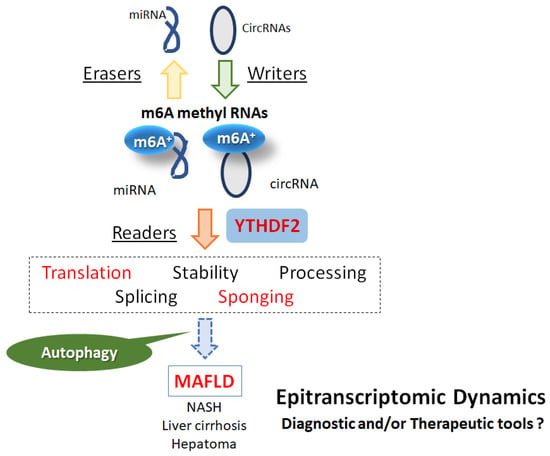
Figure 1
Open AccessReview
Investigating the Role of Non-Coding RNA in Non-Alcoholic Fatty Liver Disease
by
Samar A. Zailaie, Basmah B. Khoja, Jumana J. Siddiqui, Mohammad H. Mawardi, Emily Heaphy, Amjad Aljagthmi and Consolato M. Sergi
Non-Coding RNA 2024, 10(1), 10; https://0-doi-org.brum.beds.ac.uk/10.3390/ncrna10010010 - 31 Jan 2024
Cited by 1
Abstract
►▼
Show Figures
Non-coding RNAs (ncRNAs) are RNA molecules that do not code for protein but play key roles in regulating cellular processes. NcRNAs globally affect gene expression in diverse physiological and pathological contexts. Functionally important ncRNAs act in chromatin modifications, in mRNA stabilization and translation,
[...] Read more.
Non-coding RNAs (ncRNAs) are RNA molecules that do not code for protein but play key roles in regulating cellular processes. NcRNAs globally affect gene expression in diverse physiological and pathological contexts. Functionally important ncRNAs act in chromatin modifications, in mRNA stabilization and translation, and in regulation of various signaling pathways. Non-alcoholic fatty liver disease (NAFLD) is a set of conditions caused by the accumulation of triacylglycerol in the liver. Studies of ncRNA in NAFLD are limited but have demonstrated that ncRNAs play a critical role in the pathogenesis of NAFLD. In this review, we summarize NAFLD’s pathogenesis and clinical features, discuss current treatment options, and review the involvement of ncRNAs as regulatory molecules in NAFLD and its progression to non-alcoholic steatohepatitis (NASH). In addition, we highlight signaling pathways dysregulated in NAFLD and review their crosstalk with ncRNAs. Having a thorough understanding of the disease process’s molecular mechanisms will facilitate development of highly effective diagnostic and therapeutic treatments. Such insights can also inform preventive strategies to minimize the disease’s future development.
Full article
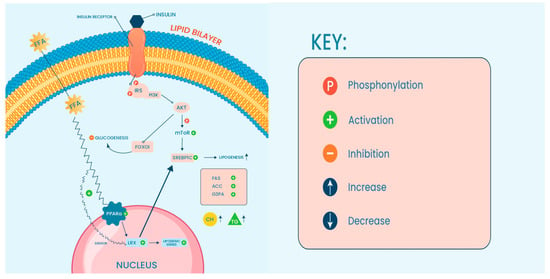
Figure 1
Open AccessArticle
HGSMDA: miRNA–Disease Association Prediction Based on HyperGCN and Sørensen-Dice Loss
by
Zhenghua Chang, Rong Zhu, Jinxing Liu, Junliang Shang and Lingyun Dai
Non-Coding RNA 2024, 10(1), 9; https://0-doi-org.brum.beds.ac.uk/10.3390/ncrna10010009 - 26 Jan 2024
Cited by 1
Abstract
Biological research has demonstrated the significance of identifying miRNA–disease associations in the context of disease prevention, diagnosis, and treatment. However, the utilization of experimental approaches involving biological subjects to infer these associations is both costly and inefficient. Consequently, there is a pressing need
[...] Read more.
Biological research has demonstrated the significance of identifying miRNA–disease associations in the context of disease prevention, diagnosis, and treatment. However, the utilization of experimental approaches involving biological subjects to infer these associations is both costly and inefficient. Consequently, there is a pressing need to devise novel approaches that offer enhanced accuracy and effectiveness. Presently, the predominant methods employed for predicting disease associations rely on Graph Convolutional Network (GCN) techniques. However, the Graph Convolutional Network algorithm, which is locally aggregated, solely incorporates information from the immediate neighboring nodes of a given node at each layer. Consequently, GCN cannot simultaneously aggregate information from multiple nodes. This constraint significantly impacts the predictive efficacy of the model. To tackle this problem, we propose a novel approach, based on HyperGCN and Sørensen-Dice loss (HGSMDA), for predicting associations between miRNAs and diseases. In the initial phase, we developed multiple networks to represent the similarity between miRNAs and diseases and employed GCNs to extract information from diverse perspectives. Subsequently, we draw into HyperGCN to construct a miRNA–disease heteromorphic hypergraph using hypernodes and train GCN on the graph to aggregate information. Finally, we utilized the Sørensen-Dice loss function to evaluate the degree of similarity between the predicted outcomes and the ground truth values, thereby enabling the prediction of associations between miRNAs and diseases. In order to assess the soundness of our methodology, an extensive series of experiments was conducted employing the Human MicroRNA Disease Database (HMDD v3.2) as the dataset. The experimental outcomes unequivocally indicate that HGSMDA exhibits remarkable efficacy when compared to alternative methodologies. Furthermore, the predictive capacity of HGSMDA was corroborated through a case study focused on colon cancer. These findings strongly imply that HGSMDA represents a dependable and valid framework, thereby offering a novel avenue for investigating the intricate association between miRNAs and diseases.
Full article
(This article belongs to the Special Issue Computational Approaches for Pinpointing the Locations and Properties of Non-coding RNAs)
►▼
Show Figures

Figure 1
Open AccessFeature PaperArticle
RNA N6-Methyladenosine Affects Copper-Induced Oxidative Stress Response in Arabidopsis thaliana
by
Bishwas Sharma, Ganesan Govindan, Yongfang Li, Ramanjulu Sunkar and Brian D. Gregory
Non-Coding RNA 2024, 10(1), 8; https://0-doi-org.brum.beds.ac.uk/10.3390/ncrna10010008 - 19 Jan 2024
Abstract
Recently, post-transcriptional regulation of mRNA mediated by N6-methyladenosine (m6A) has been found to have profound effects on transcriptome regulation during plant responses to various abiotic stresses. However, whether this RNA modification can affect an oxidative stress response in plants
[...] Read more.
Recently, post-transcriptional regulation of mRNA mediated by N6-methyladenosine (m6A) has been found to have profound effects on transcriptome regulation during plant responses to various abiotic stresses. However, whether this RNA modification can affect an oxidative stress response in plants has not been studied. To assess the role of m6A modifications during copper-induced oxidative stress responses, m6A-IP-seq was performed in Arabidopsis seedlings exposed to high levels of copper sulfate. This analysis revealed large-scale shifts in this modification on the transcripts most relevant for oxidative stress. This altered epitranscriptomic mark is known to influence transcript abundance and translation; therefore we scrutinized these possibilities. We found an increased abundance of copper-enriched m6A-containing transcripts. Similarly, we also found increased ribosome occupancy of copper-enriched m6A-containing transcripts, specifically those encoding proteins involved with stress responses relevant to oxidative stressors. Furthermore, the significance of the m6A epitranscriptome on plant oxidative stress tolerance was uncovered by assessing germination and seedling development of the mta (N6-methyladenosine RNA methyltransferase A mutant complemented with ABI3:MTA) mutant exposed to high copper treatment. These analyses suggested hypersensitivity of the mta mutant compared to the wild-type plants in response to copper-induced oxidative stress. Overall, our findings suggest an important role for m6A in the oxidative stress response of Arabidopsis.
Full article
(This article belongs to the Special Issue Non-coding RNA in the USA: Latest Advances and Perspectives)
►▼
Show Figures
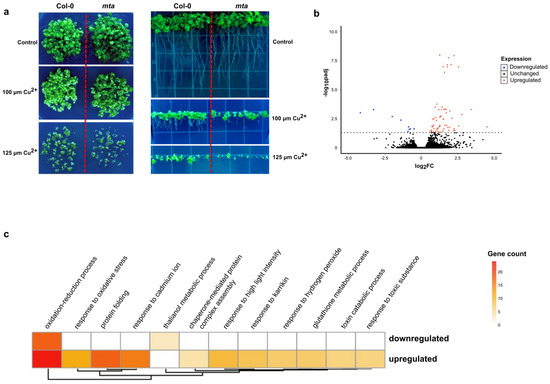
Figure 1
Open AccessReview
Role of Hydrogen Sulfide in Oncological and Non-Oncological Disorders and Its Regulation by Non-Coding RNAs: A Comprehensive Review
by
Rana A. Youness, Danira Ashraf Habashy, Nour Khater, Kareem Elsayed, Alyaa Dawoud, Sousanna Hakim, Heba Nafea, Carole Bourquin, Reham M. Abdel-Kader and Mohamed Z. Gad
Non-Coding RNA 2024, 10(1), 7; https://0-doi-org.brum.beds.ac.uk/10.3390/ncrna10010007 - 18 Jan 2024
Cited by 2
Abstract
Recently, myriad studies have defined the versatile abilities of gasotransmitters and their synthesizing enzymes to play a “Maestro” role in orchestrating several oncological and non-oncological circuits and, thus, nominated them as possible therapeutic targets. Although a significant amount of work has been conducted
[...] Read more.
Recently, myriad studies have defined the versatile abilities of gasotransmitters and their synthesizing enzymes to play a “Maestro” role in orchestrating several oncological and non-oncological circuits and, thus, nominated them as possible therapeutic targets. Although a significant amount of work has been conducted on the role of nitric oxide (NO) and carbon monoxide (CO) and their inter-relationship in the field of oncology, research about hydrogen sulfide (H2S) remains in its infancy. Recently, non-coding RNAs (ncRNAs) have been reported to play a dominating role in the regulation of the endogenous machinery system of H2S in several pathological contexts. A growing list of microRNAs (miRNAs) and long non-coding RNAs (lncRNAs) are leading the way as upstream regulators for H2S biosynthesis in different mammalian cells during the development and progression of human diseases; therefore, their targeting can be of great therapeutic benefit. In the current review, the authors shed the light onto the biosynthetic pathways of H2S and their regulation by miRNAs and lncRNAs in various oncological and non-oncological disorders.
Full article
(This article belongs to the Special Issue Non-coding RNAs: Multiple Players in Human Diseases)
►▼
Show Figures
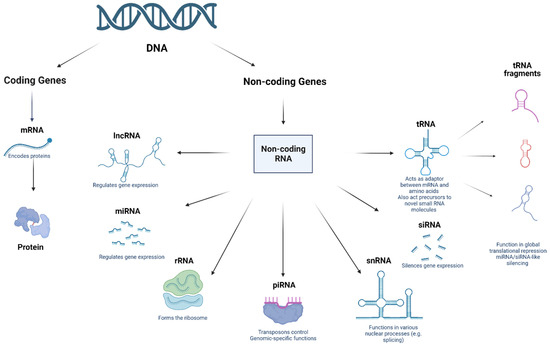
Figure 1
Open AccessArticle
sRNAflow: A Tool for the Analysis of Small RNA-Seq Data
by
Pawel Zayakin
Non-Coding RNA 2024, 10(1), 6; https://0-doi-org.brum.beds.ac.uk/10.3390/ncrna10010006 - 17 Jan 2024
Abstract
The analysis of small RNA sequencing data across a range of biofluids is a significant research area, given the diversity of RNA types that hold potential diagnostic, prognostic, and predictive value. The intricate task of segregating the complex mixture of small RNAs from
[...] Read more.
The analysis of small RNA sequencing data across a range of biofluids is a significant research area, given the diversity of RNA types that hold potential diagnostic, prognostic, and predictive value. The intricate task of segregating the complex mixture of small RNAs from both human and other species, including bacteria, fungi, and viruses, poses one of the most formidable challenges in the analysis of small RNA sequencing data, currently lacking satisfactory solutions. This study introduces sRNAflow, a user-friendly bioinformatic tool with a web interface designed for the analysis of small RNAs obtained from biological fluids. Tailored to the unique requirements of such samples, the proposed pipeline addresses various challenges, including filtering potential RNAs from reagents and environment, classifying small RNA types, managing small RNA annotation overlap, conducting differential expression assays, analysing isomiRs, and presenting an approach to identify the sources of small RNAs within samples. sRNAflow also encompasses an alternative alignment-free analysis of RNA-seq data, featuring clustering and initial RNA source identification using BLAST. This comprehensive approach facilitates meaningful comparisons of results between different analytical methods.
Full article
(This article belongs to the Special Issue Small RNAs – Big Roles: IsomiRs, tRNA Fragments, and rRNA Fragments in Human Health and Disease)
►▼
Show Figures
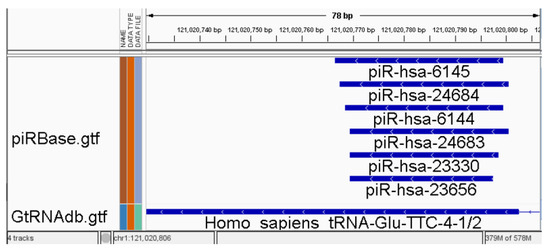
Figure 1

Journal Menu
► ▼ Journal Menu-
- ncRNA Home
- Aims & Scope
- Editorial Board
- Reviewer Board
- Topical Advisory Panel
- Instructions for Authors
- Special Issues
- Topics
- Sections & Collections
- Article Processing Charge
- Indexing & Archiving
- Most Cited & Viewed
- Journal Statistics
- Journal History
- Journal Awards
- Society Collaborations
- Editorial Office
Journal Browser
► ▼ Journal BrowserHighly Accessed Articles
Latest Books
E-Mail Alert
News
Topics
Topic in
Biomolecules, Cells, Genes, IJMS, ncRNA
MicroRNA: Mechanisms of Action, Physio-Pathological Implications, and Disease Biomarkers, 2nd Volume
Topic Editors: Y-h. Taguchi, Hsiuying WangDeadline: 20 April 2024

Conferences
Special Issues
Special Issue in
ncRNA
circRNAs in Human Healthy and Diseases
Guest Editor: Xiao-Ou ZhangDeadline: 20 April 2024
Special Issue in
ncRNA
Non-Coding RNA and Their Regulatory Roles in Plant
Guest Editor: Sujay PaulDeadline: 20 May 2024
Special Issue in
ncRNA
Computational Approaches for Pinpointing the Locations and Properties of Non-coding RNAs
Guest Editors: Sarah Rennie, Shizuka UchidaDeadline: 31 May 2024
Special Issue in
ncRNA
Evolutionary Impact of the Noncoding Genome in Higher Organisms—Recent Insights Obtained from the Molecular and Cellular Level to Systems Biology
Guest Editor: Wolfgang PollerDeadline: 30 June 2024
Topical Collections
Topical Collection in
ncRNA
The Non-Coding RNA Journal Club: Highlights on Recent Papers
Collection Editor: George A. Calin
Topical Collection in
ncRNA
Research on RNA Modification
Collection Editors: Clément Carré, Damien Brégeon





